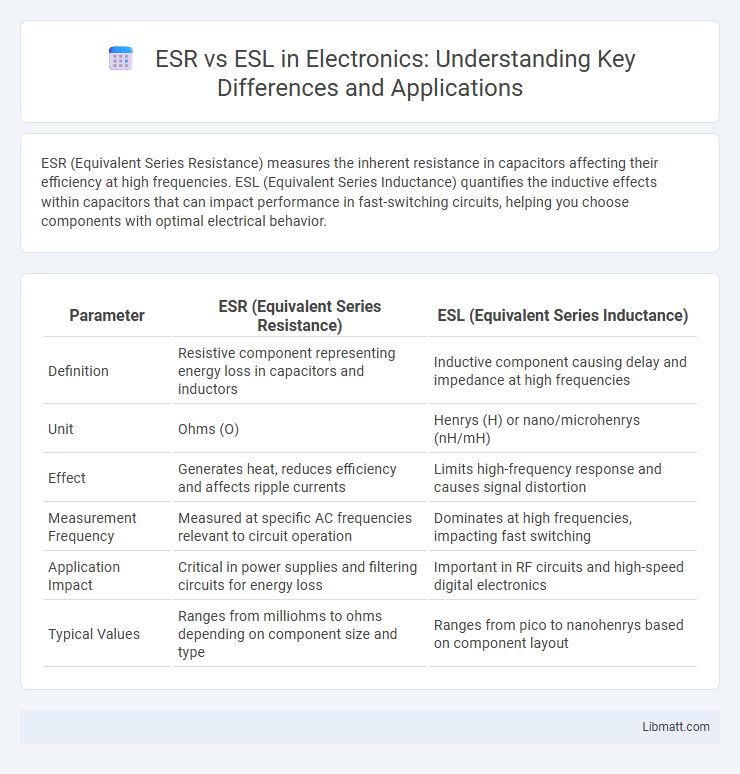ESR (Equivalent Series Resistance) measures the inherent resistance in capacitors affecting their efficiency at high frequencies. ESL (Equivalent Series Inductance) quantifies the inductive effects within capacitors that can impact performance in fast-switching circuits, helping you choose components with optimal electrical behavior.
Table of Comparison
| Parameter | ESR (Equivalent Series Resistance) | ESL (Equivalent Series Inductance) |
|---|---|---|
| Definition | Resistive component representing energy loss in capacitors and inductors | Inductive component causing delay and impedance at high frequencies |
| Unit | Ohms (O) | Henrys (H) or nano/microhenrys (nH/mH) |
| Effect | Generates heat, reduces efficiency and affects ripple currents | Limits high-frequency response and causes signal distortion |
| Measurement Frequency | Measured at specific AC frequencies relevant to circuit operation | Dominates at high frequencies, impacting fast switching |
| Application Impact | Critical in power supplies and filtering circuits for energy loss | Important in RF circuits and high-speed digital electronics |
| Typical Values | Ranges from milliohms to ohms depending on component size and type | Ranges from pico to nanohenrys based on component layout |
Introduction to ESR and ESL
ESR (Equivalent Series Resistance) and ESL (Equivalent Series Inductance) are critical parameters in the performance of capacitors and other passive components. ESR quantifies the resistive losses within a capacitor, affecting its efficiency and heat dissipation during operation. ESL represents the inductive effects caused by the capacitor's internal leads and construction, influencing high-frequency response and signal integrity in electronic circuits.
Definition of ESR (Equivalent Series Resistance)
Equivalent Series Resistance (ESR) is a measure of the internal resistance that appears in series with a capacitor's ideal capacitance, impacting its efficiency and voltage stability. ESR affects the performance of capacitors in high-frequency applications by causing power losses and heat generation within the component. Understanding your capacitor's ESR is crucial for optimizing circuit reliability and minimizing energy dissipation.
Definition of ESL (Equivalent Series Inductance)
Equivalent Series Inductance (ESL) represents the intrinsic inductive behavior of a capacitor or electronic component when subjected to high-frequency currents, modeled as an inductance in series with the device's capacitance. ESL affects the performance of capacitors by causing impedance to rise at higher frequencies, impacting signal integrity in high-speed circuits. Precise measurement and minimization of ESL are critical in designing efficient high-frequency filters and decoupling capacitors.
Key Differences Between ESR and ESL
Equivalent Series Resistance (ESR) measures the resistive component within a capacitor that affects heat generation and energy loss, whereas Equivalent Series Inductance (ESL) represents the inductive component influencing the capacitor's high-frequency performance and signal integrity. ESR primarily impacts the capacitor's thermal stability and ripple current handling, while ESL affects transient response and impedance at high frequencies. Understanding the differences between ESR and ESL is crucial for selecting capacitors in power electronics and RF applications where efficiency and frequency response are critical.
Importance of ESR in Electronic Circuits
ESR (Equivalent Series Resistance) significantly affects the performance and reliability of electronic circuits by influencing the efficiency and stability of capacitors under varying frequencies and temperatures. High ESR leads to increased power loss, heat generation, and reduced lifespan of components, making it critical for designers to select capacitors with low ESR for power supply filtering and signal integrity. Understanding ESR helps you optimize circuit design, ensuring better performance in applications like audio equipment, power converters, and communication devices.
Role of ESL in High-Frequency Applications
Equivalent Series Inductance (ESL) plays a critical role in high-frequency applications by affecting the impedance and signal integrity of electronic components, particularly capacitors. While Equivalent Series Resistance (ESR) primarily influences power dissipation and thermal performance, ESL dominates at higher frequencies, causing unwanted inductive reactance that can degrade circuit performance. Minimizing ESL is essential in high-frequency designs to ensure efficient filtering, stable operation, and reduced electromagnetic interference (EMI).
Measuring Techniques for ESR and ESL
Measuring techniques for Equivalent Series Resistance (ESR) typically involve the use of an LCR meter or an ESR meter at specific test frequencies, often 100 kHz, to accurately determine the resistive component within capacitors. Equivalent Series Inductance (ESL) measurement requires specialized impedance analyzers or vector network analyzers that capture the inductive reactance at high frequencies, providing detailed information on the parasitic inductance of capacitors or circuit elements. Both techniques rely on precise frequency selection and instrument calibration to ensure reliable characterization of ESR and ESL in electronic components.
Impact of ESR vs ESL on Capacitor Performance
Equivalent Series Resistance (ESR) and Equivalent Series Inductance (ESL) critically influence capacitor performance, affecting energy efficiency and frequency response. Low ESR reduces power losses and heat generation, enhancing capacitor reliability and longevity, while low ESL improves high-frequency impedance characteristics, enabling better signal integrity and faster transient response. You should consider both ESR and ESL values to optimize capacitor selection for high-performance electronic circuits.
Applications Where ESR or ESL Dominates
ESR (Equivalent Series Resistance) dominates in high-frequency applications such as switching power supplies, RF circuits, and signal filtering where low resistance and minimal energy loss are critical. ESL (Equivalent Series Inductance) is more significant in high-speed digital circuits and high-current transient conditions, affecting the performance of decoupling capacitors and leading to voltage spikes. Designers prioritize low ESR for efficient power delivery and low ESL for reducing electromagnetic interference and ensuring signal integrity.
ESR vs ESL: Best Practices for Circuit Design
ESR (Equivalent Series Resistance) and ESL (Equivalent Series Inductance) critically impact capacitor performance in high-frequency circuit design. Minimizing ESR reduces power loss and heat generation, while low ESL ensures stable operation by limiting voltage spikes and noise. Optimal circuit layouts incorporate capacitors with low ESR and ESL, placing them close to active components to enhance transient response and signal integrity.
ESR vs ESL Infographic

 libmatt.com
libmatt.com